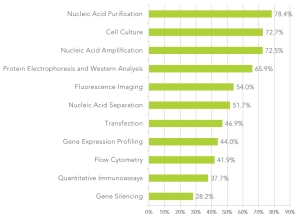It feels like we all know that there are certain laboratory practices that are common in most life science labs but how well do we know the list? Percepta polled over 1,000 global scientists to find out the relative usage of 11 techniques used in life science laboratories. While there may have been some shifting of the rank order, the results suggest that the mainstay practices have not really changed that much in recent years.
Racall the year 2002, when Science Magazine hailed the discovery of the function of short non-coding RNAs the “Breakthrough of the Year”. The discovery of the gene silencing function of small non-coding RNA has certainly impacted the research community and the pharmaceutical industry in the past 13 years. However, in 2015 Gene Silencing is the least commonly used of laboratory practices tested in our poll (common in 28.2% of life science laboratories). This is no measure of the importance of the discovery, but it is interesting to see how broadly it applies to research laboratory practices.
That said, nucleic acids still rank among the most studied classes of bio-molecule. Nucleic Acid Purification and Nucleic Acid Amplification are each common in more than 70% of life science laboratories and Nucleic Acid Separation is used in more than half of all laboratories (see figure).
Cell Culture, which can serve so many different research applications, is also among the top laboratory practices in use. Used in 72.7% of the labs we polled, it’s diversity and utility will certainly keep it hovering at the top of the list.
This brief assessment is a useful dashboard of where bio-tools companies can find stable applications that keep delivering for the research community year after year. Want more information on these application segments? Visit the Reports page at Percepta.



Leave a Reply